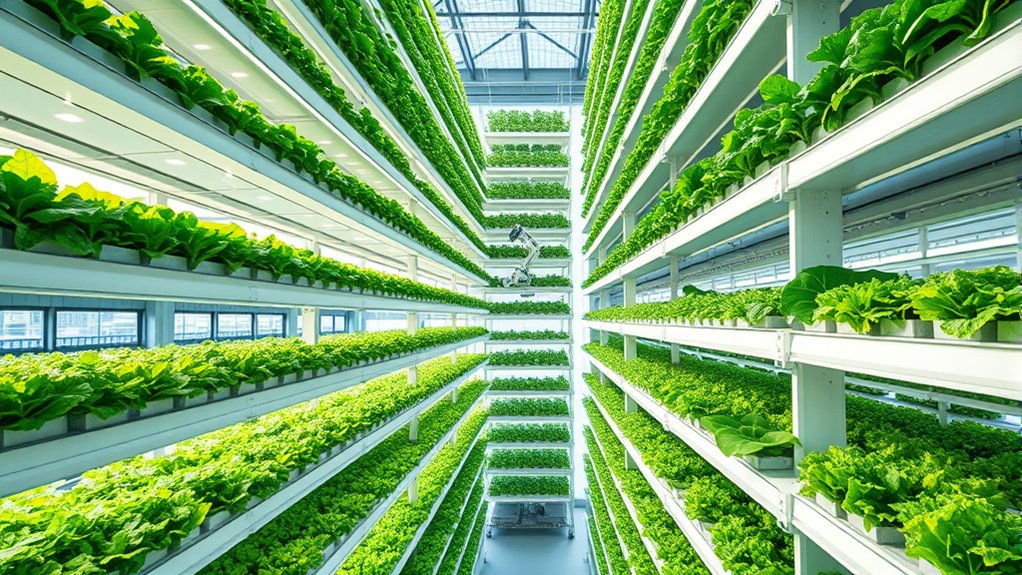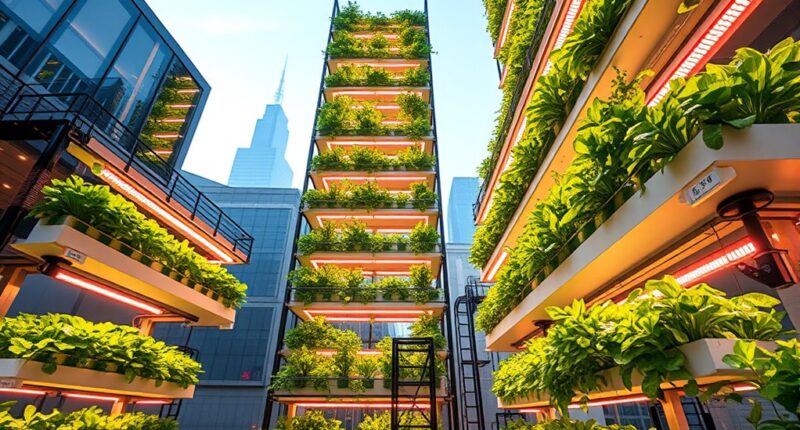Plenty’s vertical farming is reshaping agriculture by combining innovation and sustainability to grow fresh produce in urban settings. It uses advanced technology like sensors, automation, and energy-efficient lighting to maximize yields while minimizing water, land, and energy use. This approach supports local food production, reduces environmental impact, and guarantees year-round harvests. If you want to explore how this high-tech approach will influence the future of agritech, stay tuned for more insights.
Key Takeaways
- Plenty’s vertical farms utilize advanced technology and sustainable practices to produce fresh, local produce year-round in urban environments.
- The company integrates sensors and automation to optimize crop growth, reducing resource use and increasing efficiency.
- Plenty exemplifies how agritech innovations can transform urban agriculture into scalable, high-yield, eco-friendly food systems.
- Their approach promotes sustainability by minimizing water, land, and energy consumption compared to traditional farming.
- Plenty’s success highlights a future where vertical farming and agritech reshape food production to meet urban and environmental needs.

Have you ever wondered how cities can grow fresh, healthy produce without relying on traditional farms? The answer lies in vertical farming, a groundbreaking approach that’s transforming urban agriculture. Plenty’s vertical farms exemplify this shift by integrating sustainable practices with cutting-edge technological innovation. Instead of sprawling fields, they stack layers of crops inside controlled environments, making efficient use of limited space while reducing resource consumption. This method allows you to grow food year-round, regardless of outdoor weather conditions, which minimizes waste and ensures a steady supply of fresh produce.
By employing sustainable practices, Plenty’s vertical farms considerably cut down on water usage, often recycling up to 95% of it. They also reduce the need for pesticides and herbicides, creating a cleaner, safer product for consumers like you. These farms utilize energy-efficient LED lighting, which not only lowers electricity consumption but also promotes ideal plant growth. The focus is on creating an environmentally friendly system that aligns with global efforts to combat climate change and reduce carbon footprints. You’re part of a movement that prioritizes local, sustainable food sources over long-distance transportation, which means fresher produce reaches your table faster and with less environmental impact.
Technological innovation plays a crucial role in making these vertical farms viable and scalable. You might be surprised to learn that advanced sensors monitor temperature, humidity, and nutrient levels in real-time, allowing for precise adjustments that maximize yield while conserving resources. Automated systems handle tasks like watering, lighting, and harvesting, reducing labor costs and increasing efficiency. Data analytics help optimize crop selection and growth schedules, ensuring you receive the best quality produce consistently. These innovations don’t just improve productivity—they revolutionize how food is grown in urban settings, making vertical farming a sustainable, reliable alternative to traditional agriculture.
As these farms become more sophisticated, they also become more accessible to you. Imagine shopping at local markets or even nearby grocery stores where the produce is grown just miles away, using minimal water, energy, and land. It’s a future where you can enjoy fresh herbs, leafy greens, and other vegetables grown sustainably in a fraction of the space required by conventional farms. This approach not only reduces environmental impact but also strengthens local food systems, giving you more control over where your food comes from.
In essence, Plenty’s vertical farming demonstrates how merging sustainable practices with technological innovation can reshape urban food production. It’s a glimpse into a future where cities aren’t just places to live but hubs of sustainable, high-tech agriculture that benefit everyone—especially you.
Frequently Asked Questions
How Does Vertical Farming Impact Local Ecosystems?
Vertical farming can positively impact your local ecosystems by reducing land use and preserving natural habitats. It promotes urban biodiversity by creating green spaces in cities, supporting pollinators and birds. Plus, it minimizes soil health issues since it doesn’t rely on traditional soil cultivation, preventing erosion and nutrient depletion. Overall, vertical farming helps you grow food sustainably while protecting and enhancing the surrounding environment.
What Are the Startup Costs for a Vertical Farm?
Ever wonder how much it takes to start a vertical farm? You’ll likely face startup costs ranging from hundreds of thousands to several million dollars, depending on size and technology. While economies of scale can decrease per-unit expenses over time, initial investment risks remain high. You need funding for land, lighting, climate control, and automation, making careful planning essential to guarantee long-term profitability and success.
Can Vertical Farms Operate Sustainably Without External Energy Sources?
Yes, vertical farms can operate sustainably without external energy sources if they utilize renewable energy like solar or wind power. Water recycling systems help reduce water use, making the farm more eco-friendly. By integrating renewable energy and water recycling, you can minimize environmental impact, lower operating costs, and guarantee a more sustainable operation. This approach promotes energy independence and resource efficiency, vital for long-term viability.
How Do Vertical Farms Compare to Traditional Farms in Nutrient Density?
You’ll find that vertical farms often offer higher nutrient concentration and better crop quality compared to traditional farms. Since you control the environment, you can optimize light, water, and nutrients, resulting in more nutrient-dense produce. This precision allows you to grow healthier crops with consistent quality, making vertical farming a promising way to improve overall nutritional value. So, you get better, more nutritious food delivered directly from controlled, space-efficient setups.
What Innovations Are Needed to Scale Vertical Farming Globally?
Think of vertical farming as building your own Garden of Eden; to scale it globally, you’ll need innovations that promote urban integration and crop diversity. You must develop cost-effective, energy-efficient systems that fit diverse urban environments. Incorporating modular designs and advanced automation will streamline operations. Expanding crop varieties guarantees resilience and nutritional value. These innovations will help you transform urban landscapes into sustainable, productive food sources worldwide.
Conclusion
As you witness Plenty’s vertical farming revolution, imagine a future where food is abundant and waste is minimized—every harvest a demonstration of innovation’s promise. This isn’t just technology; it’s a beacon of hope in a world hungry for change. Embrace this vision, for it’s not just about crops growing upward, but about nurturing a sustainable future for generations to come. The seeds of tomorrow are being planted today—are you ready to see them flourish?








